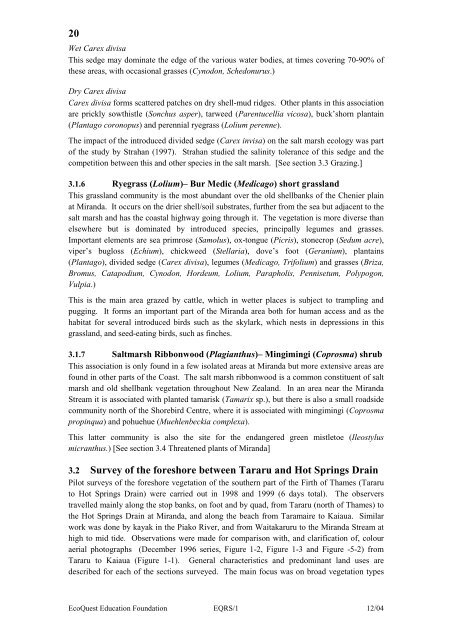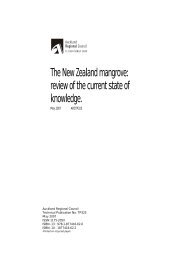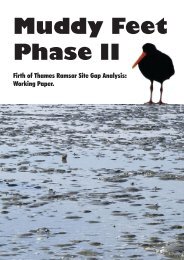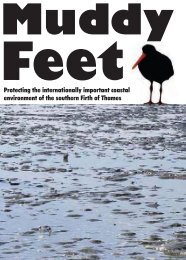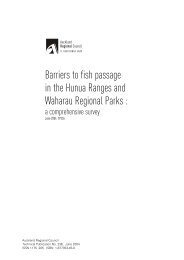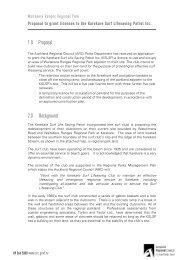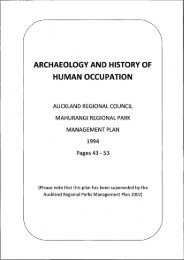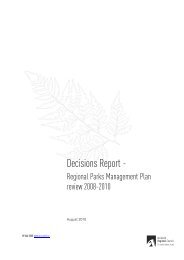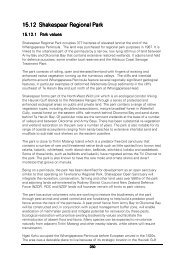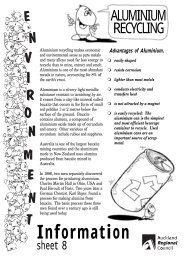MUDDY FEET - Auckland Regional Council
MUDDY FEET - Auckland Regional Council
MUDDY FEET - Auckland Regional Council
Create successful ePaper yourself
Turn your PDF publications into a flip-book with our unique Google optimized e-Paper software.
20<br />
Wet Carex divisa<br />
This sedge may dominate the edge of the various water bodies, at times covering 70-90% of<br />
these areas, with occasional grasses (Cynodon, Schedonurus.)<br />
Dry Carex divisa<br />
Carex divisa forms scattered patches on dry shell-mud ridges. Other plants in this association<br />
are prickly sowthistle (Sonchus asper), tarweed (Parentucellia vicosa), buck’shorn plantain<br />
(Plantago coronopus) and perennial ryegrass (Lolium perenne).<br />
The impact of the introduced divided sedge (Carex invisa) on the salt marsh ecology was part<br />
of the study by Strahan (1997). Strahan studied the salinity tolerance of this sedge and the<br />
competition between this and other species in the salt marsh. [See section 3.3 Grazing.]<br />
3.1.6 Ryegrass (Lolium)– Bur Medic (Medicago) short grassland<br />
This grassland community is the most abundant over the old shellbanks of the Chenier plain<br />
at Miranda. It occurs on the drier shell/soil substrates, further from the sea but adjacent to the<br />
salt marsh and has the coastal highway going through it. The vegetation is more diverse than<br />
elsewhere but is dominated by introduced species, principally legumes and grasses.<br />
Important elements are sea primrose (Samolus), ox-tongue (Picris), stonecrop (Sedum acre),<br />
viper’s bugloss (Echium), chickweed (Stellaria), dove’s foot (Geranium), plantains<br />
(Plantago), divided sedge (Carex divisa), legumes (Medicago, Trifolium) and grasses (Briza,<br />
Bromus, Catapodium, Cynodon, Hordeum, Lolium, Parapholis, Pennisetum, Polypogon,<br />
Vulpia.)<br />
This is the main area grazed by cattle, which in wetter places is subject to trampling and<br />
pugging. It forms an important part of the Miranda area both for human access and as the<br />
habitat for several introduced birds such as the skylark, which nests in depressions in this<br />
grassland, and seed-eating birds, such as finches.<br />
3.1.7 Saltmarsh Ribbonwood (Plagianthus)– Mingimingi (Coprosma) shrub<br />
This association is only found in a few isolated areas at Miranda but more extensive areas are<br />
found in other parts of the Coast. The salt marsh ribbonwood is a common constituent of salt<br />
marsh and old shellbank vegetation throughout New Zealand. In an area near the Miranda<br />
Stream it is associated with planted tamarisk (Tamarix sp.), but there is also a small roadside<br />
community north of the Shorebird Centre, where it is associated with mingimingi (Coprosma<br />
propinqua) and pohuehue (Muehlenbeckia complexa).<br />
This latter community is also the site for the endangered green mistletoe (Ileostylus<br />
micranthus.) [See section 3.4 Threatened plants of Miranda]<br />
3.2 Survey of the foreshore between Tararu and Hot Springs Drain<br />
Pilot surveys of the foreshore vegetation of the southern part of the Firth of Thames (Tararu<br />
to Hot Springs Drain) were carried out in 1998 and 1999 (6 days total). The observers<br />
travelled mainly along the stop banks, on foot and by quad, from Tararu (north of Thames) to<br />
the Hot Springs Drain at Miranda, and along the beach from Taramaire to Kaiaua. Similar<br />
work was done by kayak in the Piako River, and from Waitakaruru to the Miranda Stream at<br />
high to mid tide. Observations were made for comparison with, and clarification of, colour<br />
aerial photographs (December 1996 series, Figure 1-2, Figure 1-3 and Figure -5-2) from<br />
Tararu to Kaiaua (Figure 1-1). General characteristics and predominant land uses are<br />
described for each of the sections surveyed. The main focus was on broad vegetation types<br />
EcoQuest Education Foundation EQRS/1 12/04


